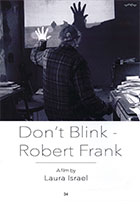
Don’t Blink: Robert Frank 2015
Distributed by Grasshopper Films, 12 East 32nd St., 4th Floor, New York, NY 10016
Produced by Melinda Shopsin and Laura Israel
Directed by Laura Israel
DVD, color and b&w, 82 min.
College - General Adult
Art
Date Entered: 12/12/2016
Reviewed by Marsha Taichman, Cornell UniversityThis film about photographer and experimental filmmaker Robert Frank is a sensory overload. I mean this in the best possible way. Laura Israel, Frank’s long-time collaborator and friend, compiled footage and crafted this film over the course of eight years, and Don’t Blink is an encapsulation of his work. Frank is revealed as an artist and a person, and we are able to experience his arrogance and impatience, as well as his sweetness and charm. The film excels in its use of Frank’s work as raw material. It starts with an exploration of Frank’s seminal book The Americans (1969), where he crossed the United States taking photographs of people from all walks of life, and shows the images themselves as well as print and film footage of the book’s reception. Both still and moving images from Frank’s entire career are included, at times in rapid succession.
The soundtrack of the film is deliberate, punchy, nuanced and jarring. Songs featured are performed by Bob Dylan, the Rolling Stones, Yo La Tengo and the Kills. While I enjoyed the music, I can see how it might be distracting to some viewers.
It would be hard to keep up with the clipped pace of Don’t Blink were it not for the quieter moments. There are calm scenes in Frank’s house in Nova Scotia that he shares with his longtime partner, artist June Leaf. Time seems to slow when Frank is discussing loss, which is arguably the major theme in his work. Loneliness also features heavily. Both of Frank’s children, Andrea and Pablo, died tragically, and their absence influences his photographs. At one point, Frank muses, “By making art, you can change fate and deal with fate.”
About twenty minutes before the end of the film, there is a wonderful scene where Frank is working on a piece. After a montage of photographs from Beirut in 1991, Frank hunches over a light table scratching words into the wet emulsion of his negatives. Frank’s voice over asks, “Words, statements, legends for people to understand more. What is the artist saying?” Then we cycle through footage of works that incorporate words: Be happy, look up for hope, sick of goodby’s [spelling his]. One of the great strengths of the film is that Frank’s work is featured more prominently than his biography.
Don’t Blink is a worthy testament to one of the best photographers of our time.